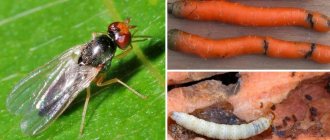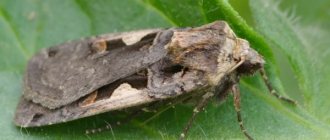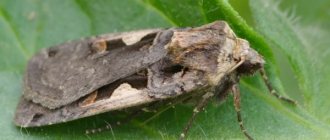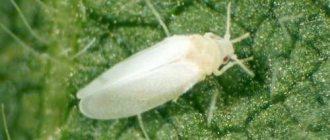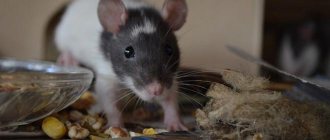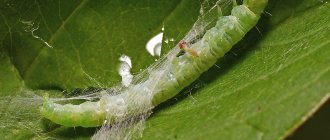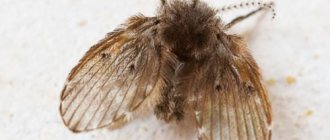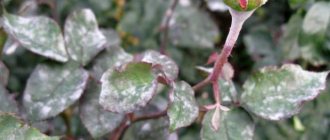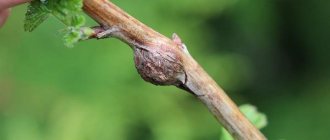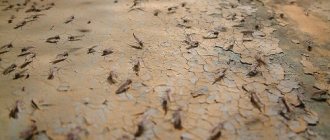Some butterflies are considered pests. The leaf roller is one of these insects. This is a real garden pest. Gardeners must get rid of insect eggs and larvae. Otherwise, the entire crop may be destroyed. The insect is small. The wingspan usually does not exceed 2.5 cm. The last wings are wide. The back corner is rounded. Leaf rollers are most active in the morning and evening. Insects can easily be found in vegetable gardens. Caterpillars are polyphagous and voracious.
The leaf roller is a dangerous pest
What description
The caterpillars are almost completely smooth. There are single villi. The insect has 16 legs. The head is brown or completely black. The body has a standard shade - yellowish or green.
The pest can be characterized by the following characteristics:
- the antennae are bristly;
- a shortened proboscis, which can be underdeveloped, but there are no tentacles;
- jaw tentacles three-jointed.
When at rest, the wings are shaped like a roof. The upper ones are usually longer than the lower ones. At the base they can expand.
Caterpillars are often located on hills. There are occipital and supra-caudal scutes. Leaf rollers consume leaves from various plants. Damaged leaves are pulled together by cobwebs and curled. This is where the pest is located. If there is danger, the insect immediately gets out.
The caterpillars of this butterfly are small and feed on leaves.
The larvae appear in early spring. Worm-shaped caterpillars. The body length does not exceed 2 cm. The pest moves quickly due to the presence of 8 pairs of legs. In a short period of time, the parasite can go around the entire garden and cause damage to many plants.
The caterpillar has 12 eyes - 6 on each side. There is a spinning gland, which is involved in the creation of the cocoon. The larvae often eat buds, sprouts and buds. A damaged plant is not capable of further ripening.
What are the development features
Active reproduction and development is possible only in the presence of satisfactory conditions. Must be present:
- temperature within 19-25 degrees;
- increased humidity level.
In temperate climate zones, the insect is capable of hibernating at any stage of development. This state is called diapause. This is what allows the pest to tolerate temperature drops down to -35 degrees.
Butterflies hibernate in cold weather
During diapause, the insect occupies secluded places, namely:
- soil;
- layer of snow;
- seeds;
- stems;
- tree bark, etc.
There the insect is absolutely safe and can wait out the severe frosts. When living in a tropical climate, the life cycle of leaf rollers is continuous. Hibernation is likely only in extreme cases, when humidity levels drop and drought occurs.
On the territory of Russia, leaf rollers are capable of producing only one generation per year. The hibernation stage can extend significantly due to unstable weather conditions.
What are the types?
There are many types of leaf rollers, the main ones are described in the table.
| Buraya | It has a brown color with a gray tint. There is a pronounced brown pattern on the front wings. Females are much brighter than males, which are inconspicuous. The butterfly season begins in early summer. Life expectancy does not exceed 2 weeks. The insect is active in the evening. At night, individuals mate. Eggs in the amount of 2-4 pieces are laid in the bark of a tree. The emergence of a generation occurs in April-mid-May. The caterpillar has a deep black color. The length reaches 2-2.5 cm. At the initial stages, nutrition includes buds and blossoming plants. The caterpillar stage of the representative lasts about a month. Afterwards pupation occurs, which lasts 2 weeks. The brown leaf roller is polyphagous. Poses a danger to fruit trees and other plants. |
| Spruce | Affects young spruce trees. Trees that are already weakened are selected. The insect lives under the bark. The vital activity of an individual leads to disruption of plant growth. Tree branches die. The leaf roller has short but wide upper wings. The color is brown with an olive tint. The back pair is less saturated and also has a peculiar fringe. The butterfly season begins in May. Until this time, the individual is at the caterpillar stage. |
| Spruce cone | The wingspan reaches 1.5 cm. The front wings are dark brown. There is a peculiar metallic sheen. There is a white border. The caterpillar's body is deep yellow. The insect damages fir cones. Often found in Russia. The insect lays eggs in cones. |
| Deciduous | Has narrow front wings. The pupa is light brown. The insect lays eggs on coniferous trees. Pupation occurs at the base of the tree. Caterpillars feed on needles. |
| Spruce needle beetle | The front pair of wings are dark brown. Small silver spots present. Caterpillars are green or yellow with a brown tint. The pupa is brown. Has some kind of hooks. The butterfly lays eggs on last year's needles. At first the caterpillar lives on the surface, and then eats the needles from the inside. The insect damages trees that are 10-35 years old. |
| Fatty fir | The insect is much larger than its relatives. The caterpillar reaches 2.2 cm in length. The individual lays eggs on the surface of the needles. The pest eats the needles. The leaf roller causes significant damage to fir trees. |
The table describes only the main types. There are 160 varieties in total. The greatest danger to agriculture are the subspecies that:
- eat all plants;
Those species that harm fruit trees are dangerous.
- destroy fruit trees;
- prefer colors.
When the listed varieties appear, destruction measures should be taken immediately so as not to lose the planned harvest.
Leaf roller on garden trees and plants
On the apple tree
These, perhaps the most common garden fruiting crops, are capable of attacking several types of leafrollers at once:
1-Kidney spinner; 2-Bunch leaf roller; 3-Eastern codling moth.
- Bud spinner - the front wings of this butterfly are light yellow, and the basal field has a characteristic bluish tint; it is already clear from the name that the larvae of these insects especially prefer the buds of an apple tree.
- Bunch leaf roller - this species has brown forewings with a pattern of light transverse stripes.
- Eastern codling moth - this one loves already set fruits; its wings are brown, with small white streaks.
- Hawthorn leaf roller - characterized by the fact that the pattern of males is much paler than that of females.
- The apple leaf roller has relatively large larvae - they grow up to 1.8 cm long.
1-Hawthorn leaf roller; 2-Apple leaf roller.
Pear
Pear trees are affected by larvae that nest on apple and plum trees, but they also have their own “own” troubles:
- Pear moth - the front wings are gray, with transverse stripes, the hind wings acquire a brown tint.
- Oak leaf roller - its wings are yellowish green, its abdomen is gray, and its head is yellow with pallor.
1-Pear moth; 2-Oak leaf roller.
These leafrollers are especially active in attacking young pear shoots, preventing the development of fruits.
On the plum
In addition to the above, plum trees are also visited by other species that prefer these trees:
- Plum codling moth - there are characteristic dots on the front brown wings with a purple tint; the hind wings are much paler.
- Variable leaf roller - on the wings, in addition to gray, there is a noticeable presence of white.
1-Plum moth; 2-Variable leaf roller.
On apricot and peach
And one more alarming feature: these crops already do not take root very well in the temperate Russian climate, and after treatment with the chemicals necessary to destroy the larvae, they may be delayed in growth, or even die.
All types of leafrollers, which have already been mentioned, are greedy for these crops. Only these trees are affected by them much faster.
On the grapes
The grape leaf roller is a very dangerous pest for this crop. Only one larva is able to roll several leaves at once into tubes and cocoons, which turn brown and then fall off.
Even before fresh foliage appears, these caterpillars happily eat grape buds, later inflorescences and even the grape bunches themselves.
On currants
The currant leaf roller is capable of laying up to 150 eggs. from which the larvae emerge - one can only imagine what harm just one butterfly can do in this way.
On raspberries
Raspberries do not suffer from pests as much as currants, but they can also suffer.
The following species are especially dangerous for this crop:
- The frost leaf roller is a small gray butterfly with a distinct covering of hairs;
- Reticulated leaf roller - it has a netted pattern and is brown in color.
1-Frost leaf roller; 2-mesh leaf roller.
Both species affect not only ovaries and leaves, but also young fruits.
On roses
The roseate leaf roller rolls the leaves of the flower like a cigar. The larva is able to withstand temperature drops of almost 30 degrees, however, provided that a lot of snow falls, under which the pests hide from the frost.
First, the caterpillar eats the leaves, then moves to the inflorescences and, finally, to the buds.
What are the stages of maturation
The first stage is the egg. The insect lays them in the spring. The female leaf roller is fertile. Fertilization begins 3 days after the start of pupation. The female chooses fruit trees to lay eggs. The insect finds the plant by its distinct smell. There the leaf roller lays a small group of eggs. The shell color is dark.
Eggs are localized in cracks in the bark, less often in inflorescences. The upper shell protects even from severe frosts. The second stage is caterpillars. Polyphagous larvae appear after 2 weeks and have a smooth body. If you touch an insect, it will not fall, but will hang on its dense web.
Pupation occurs in July. The stage lasts 2 weeks. An adult emerges from the pupa. Insects of the second generation overwinter in a thick cocoon and emerge only after warming. The shell is localized in crevices on trees and branches.
The caterpillar makes a cocoon from leaves, where it later turns into a butterfly.
The last stage is the butterfly. In this form, the insect prepares new offspring. The color of the wings directly depends on the subspecies of the insect. Often the color of the butterfly is dull and pale.
How to get rid of fruit budworm
The fruit budworm survives the winter in the bark of fruit trees. At first it feeds on tree buds. An adult lays 150 eggs at a time. The insect is polyphagous. Caterpillars are capable of destroying all the fruit trees in the garden.
Control measures include:
- regular spraying of all fruit trees (Fufanon or Kemifos);
- manual collection and destruction of pupae.
Treatment of trees must be comprehensive.
Similar measures to combat the multi-colored and moon-shaped leafroller. Insects often attack the apple tree. The tree should be sprayed 2 weeks after flowering ends.
This video will help you fight this butterfly:
Under supervision
If oak green budworm has been found on a tree this season, call a qualified tree care professional in the fall. He must inspect the infected tree: cut off the shoots and count how many clutches have been laid.
As already noted, oviposition is usually destroyed by severe frosts - below -30.-35 °C. Therefore, in March, the inspection is carried out again to find out how many clutches have overwintered.
THIS IS IMPORTANT TO REMEMBER!
An inspection in March should definitely be done so that in the event of the death of the pest, you do not waste money on pointless treatment and do not once again expose the fragile ecosystem to chemical influence.
If winter has not caused serious harm to the potential offspring of the leaf roller, then you should think about ways to deal with the unwanted guest.
Among the available methods that do not require professional knowledge and equipment:
- creating living conditions for the natural enemies of the leaf roller - insectivorous birds, ants, ground beetles, bugs, wasps, nematodes. To do this, it is necessary to preserve anthills, arrange nesting places and feeders for insectivorous birds (especially starlings), and build houses for insects.
House for insects
House for insects
- on very young oak trees, the caterpillars can be collected mechanically, carefully inspecting and picking by hand.
If you are the owner of large oak trees, then you need professional help!
It will be necessary to treat the entire surface of the crown with insecticides or biological preparations using powerful motorized sprayers or cold fog generators.
Treatment with a cold fog generator
Treatment with a cold fog generator
The main thing here is to choose the right time for processing.
It is carried out immediately before blossoming and during the period of oak buds, in the early or afternoon hours (hot hours should be excluded), in dry weather.
For greater efficiency, it is necessary to check the weather forecast so that there is no precipitation within 2-3 days after spraying. Biological agents are most effective when used against younger caterpillars.
__________________________________________________________________
For reference:
Entomophages are insects that feed on insects and their larvae. Can be used in pest control.
Biotope is a section of the earth’s surface (land or body of water) with similar environmental conditions, occupied by a certain biocenosis.
___________________________________________________________________
How to deal with pests in the garden
The leaf roller can infest the garden and cause damage to flowers. The insect harms:
- rosebuds;
- peonies;
- lilies.
Only safe means are suitable for control, which will destroy insects but will not harm the affected plants.
Preventive spraying is carried out in the spring. This should be done immediately after the buds open. Single caterpillars are collected by hand and immediately destroyed. Plants are inspected regularly and control begins when the first parasites appear.
It is also necessary to control the number of butterflies. At this stage it is also necessary to destroy insects. Dimilin is chosen to combat caterpillars. The solution has an intestinal effect on insects. The drug lasts for one and a half months. The chemical has a low toxicity rating. The product is harmless to humans.
Calypso is allowed. The drug is safe for humans and beneficial insects. It is not addictive, therefore it fully retains its effectiveness. Destroys sucking and gnawing insects.
For protection you can use the drug Calypso
Avant allows you to destroy the pest at any stage. Gets rid of butterflies and caterpillars, as well as eggs. Approved for use from the beginning of spring. For any treatment, it is important to follow the recommendations specified in the instructions for the drug.
Ways to fight
Biological drugs
These are drugs that do not contain chemical components, but are harmful to caterpillars. They contain bacterial spores that usually develop in soil, but in lower concentrations. After the dried solution with these bacteria is eaten by the leaf roller larva, they begin to secrete toxins that destroy the intestinal walls of the caterpillar, as a result of which it dies.
An example of drugs in this group is Lepidocide . It is available in powder form. For spraying, prepare a solution of the drug by mixing 25 ml/g in 10 liters of water. To make the substance stick to the leaves, it is recommended to add a little dry milk to the mixture - about 2 tbsp.
The actual analogues of this drug are Dendrobacillin and Bitoxibacillin .
- Spraying is carried out when the first signs of infection appear.
- If necessary, the treatment is repeated after a week.
Chemicals
They are more effective, but also more toxic, and are also applied to the tree by spraying:
- Alatar is diluted in 10 liters of water in an amount of 4-5 ml.
- Karbofos is dissolved in the same amount of water in the form of 10 ml of the product.
- The broad-spectrum drug Durbosan , which is a systemic drug, is diluted with water in the same proportions.
If necessary, the concentration of the drug can be doubled.
